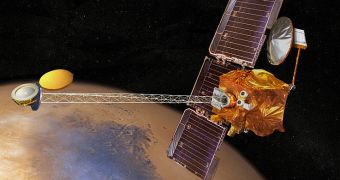After snatching a world record last year, the NASA Mars Odyssey orbiter has now officially turned 10. The spacecraft was launched back in 2001, and it still supplies a wealth of data about the Red Planet.
Odyssey launched on April 7, 2001, from Space Launch Complex 17A at the Cape Canaveral Air Force Station (CCAFS), in Florida. It took off to space aboard the Delta II 7425 delivery system.
It arrived at, and reached orbital insertion around Mars several months later, and then began its primary science mission immediately. Of the 10 years the orbiter has been operational, 9 years and 2 months have been spent conducting actual scientific investigations.
Thus far, the relay antenna aboard Mars Odyssey has sent back in excess of 130,000 images, collected with the advanced suite of instruments that the orbiter is equipped with. Datasets cover climate, mineralogy and geology, experts say.
This spacecraft is one of the main reasons why we now know that there was liquid water on the Martian surface at one point in its distant past. The NASA Phoenix Mars Lander mission, which landed on our neighboring planet in 2008, confirmed Odyssey's findings.
The spacecraft turned out to be so sturdily-built, that it even exceeded the longevity record set by the NASA Mars Global Surveyor mission (1997-2006). In December 2010, the Odyssey officially became the longest-lived orbiter around the Red Planet.
All of the studies conducted using the orbiter made excellent use of its advanced instrument suite, which features the Gamma Ray Spectrometer (GRS), the Thermal Emission Imaging System (THEMIS), and the Mars Radiation Environment Experiment (MARIE).
With these tools, experts were able to produce unbelievable images of Martian topography, and also to map the spread of chemical elements and minerals across the planet's surface. Temperature measurements were also conducted for important swaths of land.
In addition, Odyssey also determined that the amount of radiation present in low-Mars orbit (LMO) is two times higher than that present in low-Earth orbit (LEO). This is of tremendous importance for astronauts who will visit the Red Planet in the future.
But the orbiter's role does not stop here. It also provided critical mission support for the twin Mars Exploration Rovers (MER) Spirit and Opportunity, as well as for Phoenix. Next year, it will also support the landing and operations of the Mars Science Laboratory (MSL) rover Curiosity.
Odyssey is joined in Martian orbit by the newer Mars Reconnaissance Orbiter (MRO), which arrived there in 2006, and by the European Space Agency's (ESA) Marx Express spacecraft, Universe Today reports.
Together, these three orbiters are providing invaluable data on several critical aspects of the Red Planet. They are also contributing to the effort of putting humans on Mars within the next couple of decades.

 14 DAY TRIAL //
14 DAY TRIAL //